“This post contains affiliate links, and I will be compensated if you make a purchase after clicking on my links.”
Last Updated on June 21, 2023
Regarded for their gentle personality and enormous size, the Great Dane breed also comes in a wide range of coat colors, patterns and markings. And each one of these colors just adds splendor and personality to every Great Dane.
From this wide variety of Great Dane colors, you’ll find that some are more favored than others as per the breeds standard. And in this article, you’ll learn everything about the many colors, patterns and markings of the Great Dane breed.
Great Dane Colors Breed Standards
The American Kennel Club enumerates 17 purebred Great Dane coat colors. Out of which 7 are official, 9 are standard breed coat and 8 are registered coat varieties.
While the Great Dane comes in an array of colors, the American Kennel Club (AKC)’s breed standards only recognizes these seven as the official Great Dane colors:
- Black
- Brindle
- Blue
- Fawn
- Harlequin
- Mantle
- Merle
Since these seven are the only recognized colors, they are more favored and popular than others. Furthermore, these are the only coat colors allowed to participate in the Great Dane Club of America (GDCA) and AKC dog shows.
Aside from these seven official Great Dane colors, the AKC also approves and recognizes two more coat colors as standard colors, and these are:
- Black and White
- White
The Official Great Dane Colors
The color superiority for breeding is mainly determined by color families. The general rule to produce a Great Dane with an official coat color is to cross two Great Danes from within these official colors.
The most preferred cross for breeding are Black x Blue, Harlequin x Mantle, and Fawn x Brindle. And the standard markings for the Great Dane breed dogs are black and white markings with black mask for these coat colors.
Continue reading below for an all inclusive discussion on the seven official Great Dane colors, patterns and markings.
1. Black Great Dane
A Black Great Dane‘s color, according to AKC and GDCA, “shall be glossy black”. A rich black coat depicts a dazzling shine while in sunlight. And this can be further improved with regular and proper grooming.
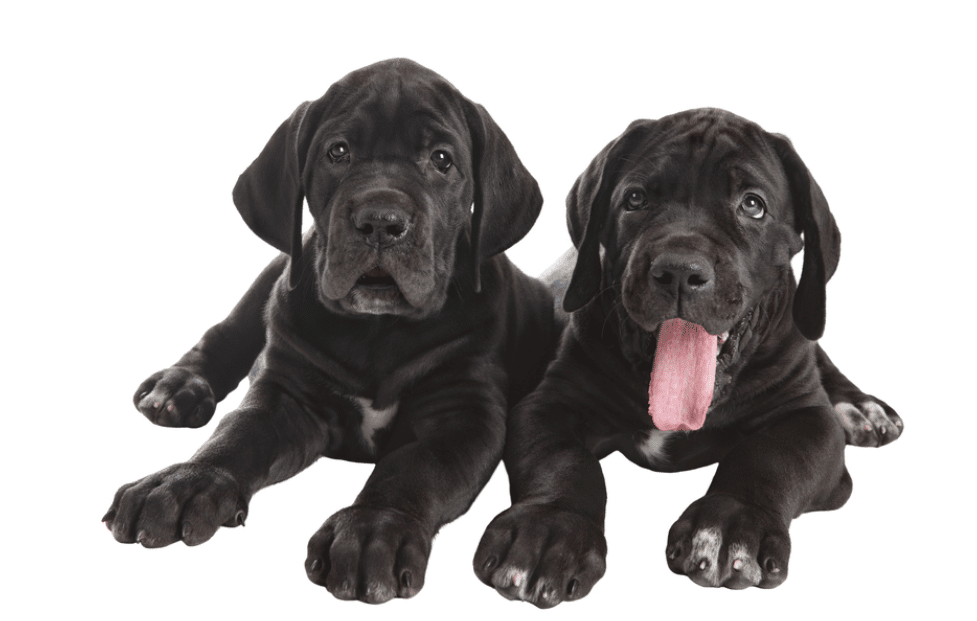
Patterns and Markings
There are a number of Black Great Danes that have small spots and markings on their toes and chests. According to AKC standards, these are not desirable.
Generally, a Black Great Dane with white markings can be considered a “mismark” and cannot join dog shows. These markings are also an unpopular mark of the pedigree. Although, minor and small white markings are usually allowed for show dogs. Undoubtedly, if you wish to enter Great Dane dog shows, then a flawless and glossy black Great Dane without any markings is preferred.
Besides white markings, the Black Great Dane also has mismarks where it has fawn, brindle, harlequin, mantle, and blue markings. Black Great Danes with any colored markings are undesirable as per breed standards. However, if what you’re looking for is a Great Dane pet, then these unofficial patterns and markings should not be a big deal.
Breeding
Black Great Dane puppies are mainly produced by breeding Black Great Danes. And they are also produced when Black Great Danes are bred with other official coat colored Danes like the Harlequin Great Dane, Blue Great Dane and Mantle Great Dane.
2. Brindle Great Dane
As per breed standards, the Brindle Great Dane’s base coat color should be yellow gold and should be brindled with black cross stripes. And this coat color is also referred to as “tiger stripes” because of its similarity to a tiger’s coat.
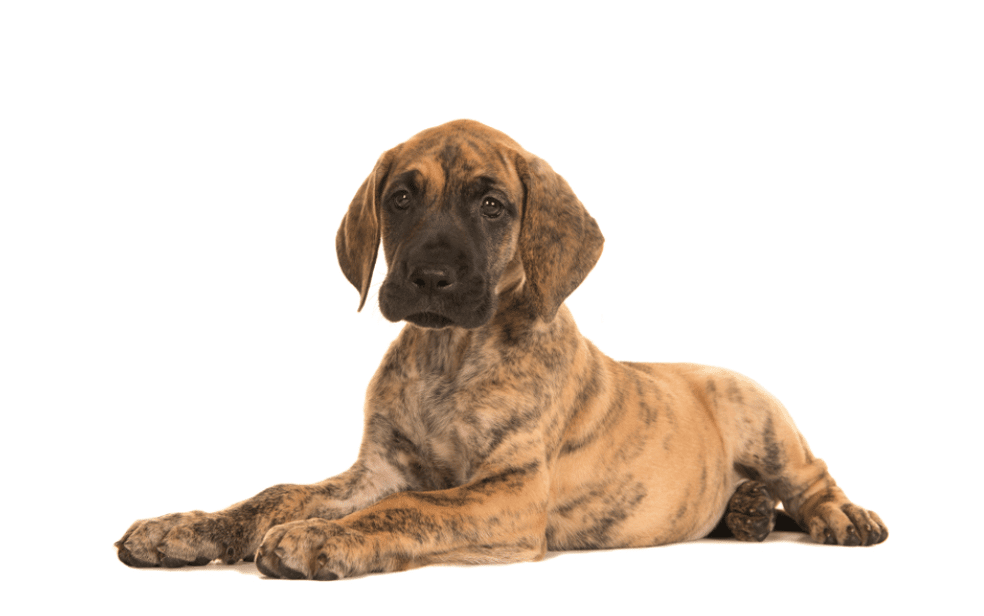
Patterns and Markings
According to AKC and GDCA, the Brindle‘s coat patterns should be:
Brindle shall have a black chevron pattern with a black mask. Black should appear on the eye rims and eyebrows and may appear on the ears and tail tip. The more intense the base color and the more distinct and evenly brindled, the more preferred will be the color. Too much or too little brindling are equally undesirable. White markings on the chest or toes; black fronted; dirty colored Brindles; are not desirable.
Brindle Show Dog Great Dane
For a Brindle Great Dane to be able to join dog show competitions, they should be perfectly brindled. The more intensive the base color and the more distinct and evenly brindled they are, the better.
This also means that Brindles who have too much or too little stripes are disqualified from dog shows and are not as favored. Furthermore, regular stripping is desirable than irregular stripping. And Great Dane lovers favor the base coat shade of golden yellow and deep yellow brown for the Brindle Great Dane.
Brindle Great Danes also have mismarks. At times, their brindle stripes are blue instead of black and sometimes their base color isn’t a shade of yellow.
Breeding
While breeding Brindle Great Dane puppies is not rare, it can be a bit challenging and unpredictable. Even when two perfect Brindles are bred, they will still produce Fawn and/or Brindle puppies.
Furthermore, when these two perfect Brindles are bred repeatedly, the litter’s base coat color will get darker and the stripes lighter. This is why, at times, Brindles are bred with Fawns to bring back the distinctness of the coat color and its patterns.
3. Blue Great Dane
A Blue Great Dane’s color according to breed standards, “shall be a pure steel blue”. The coat color come in different shades of blue but the most popular is a solid grey-ish blue coat, which is what the breed standards consider as “pure steel blue”.
They are sometimes regarded as a “tainted” variant of the Black Great Danes. And they are mistaken as Weimaraners, especially when they’re young, because of their striking resemblance with the breed.

Patterns and Markings
Similar to a Black Great Dane, a Blue Great Dane with white markings on its chest and toes are not desirable according to breed standards.
Fawn, Brindle, and white-marked Blue Great Danes are not viewed as an accurate pedigree and are considered “mismarks”.
Breeding
Blue Great Dane puppies, unlike other Great Dane colors, cannot be produced through cross breeding two different-colored Danes.
In this case, Blue Great Danes are born when two Blue or Black Great Danes are bred together. That means, two Black Great Danes can also give birth to Blue Great Danes.
4. Fawn Great Dane
Among all the Great Dane colors, the Fawn coat is the most popular and common. And generally, when people think of the Great Dane breed, a Fawn Great Dane comes into mind first. This may be thanks to popular characters in mainstream media such as Scooby Doo and Marmaduke.
According to AKC and GDCA, the Fawn Great Dane‘s coat color “shall be yellow gold“. And that the deep yellow gold hue of their coat is always given preference over other hues of the same color.

Patterns and Markings
When it comes to a Fawn’s patterns and markings, the breed standards states that black should appear on the dog’s eye rims, eyebrows and the muzzle. And the black can also appear on the ears and tail tips.
Fawns that are dirty-colored, black-fronted or those with white markings on their chest and toes are not desirable as per breed standards.
Breeding
Even though Fawn is the most common coat color for the breed, it is actually difficult to breed them. In order to produce a Fawn Great Dane puppy, both parents must carry the recessive Fawn gene. And cross breeding Fawn, Harlequin, and Brindle Great Danes can produce Fawn Great Dane puppies.
5. Harlequin Great Dane
Harlequin Great Danes are easy to differentiate from other Great Dane colors. Their coat is characterized by black patches on a white coat. And among all the Great Dane colors, the Harlequin is the rarest and therefore, the most expensive.
According to AKC and GDCA standards, a Harlequin Great Dane’s “base color shall be white with black torn patches. Merle patches are normal.”
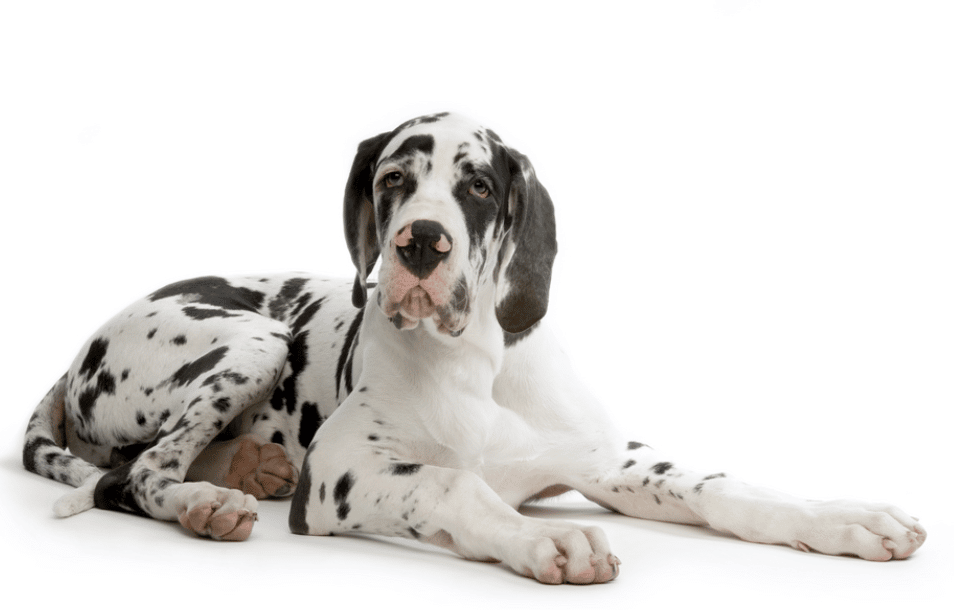
Patterns and Markings
As per breed standards, a desirable Harlequin’s patterns and markings are:
Black torn patches well distributed over the body; with whole or partial white neck. Black pigment may be seen on the skin in white areas. No patch should be so large as it appears to be a blanket. Eligible but less desirable, are black hairs showing through the white base coat which gives a salt and pepper or dirty appearance.
Breeding
It is difficult to breed Harlequin Great Danes. In fact, the Harlequin Great Danes hold genes of many other color families. It might have black, white, merle, or mantle patches on its white coat. And the Harlequin Great Dane must be allowed to mature first in order to determine its pedigree.
And to produce Harlequin puppies, breeders usually mate Merles or Harlequins with Mantles. Though breeders usually mate Harlequins with Mantles as breeding with Merles produce puppies with certain health problems.
6. Mantle Great Dane
The Mantle Great Dane should have the following color as stated by AKC and GDCA’s breed standards, “Black and white with a black blanket extending over the body.”
Due to the similarity of the coat color to Boston Terriers, Mantle Great Danes were called Boston Great Danes until the late 1990s.
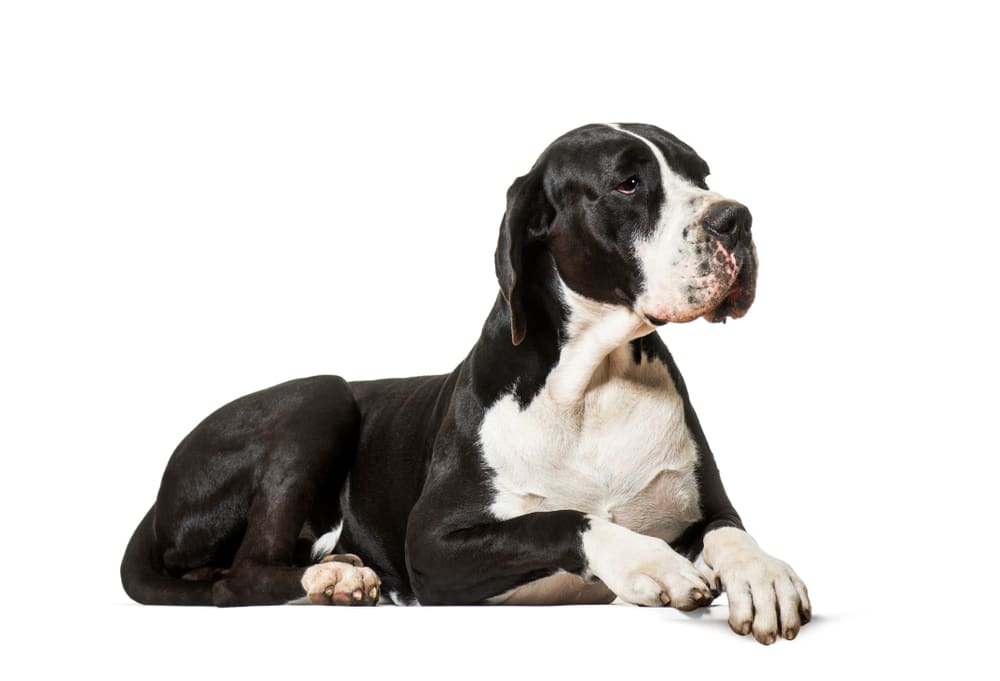
Patterns and Markings
As per breed standards, a Mantle Great Dane should have the following patterns and markings:
Black skull with white muzzle; white blaze is optional; whole or partial white neck; a white chest; white on whole or part of the forelegs and hind legs; white tipped black tail. A small white break in the blanket is acceptable. Black pigment may be seen on the skin in white areas.
Breeding
Mantle Great Dane puppies are born by breeding Mantles with Harlequins. Interestingly, when you breed these two coat colors, there is a greater chance of producing a litter of Mantle puppies than Harlequins.
Although, you have to be careful. Sometimes, mismarked Black Great Danes are disguised and sold as Mantle Great Danes.
7. Merle Great Dane
A Merle Great Dane looks similar to a Harlequin Great Dane. But their most striking difference is their base coat color because a Merle has a grey base color instead of white.
Merle Great Danes were only made one of the official Great Dane colors in 2018. And according to breed standards, their color shall be, “a pale gray to dark gray merle base color with black torn patches within.”
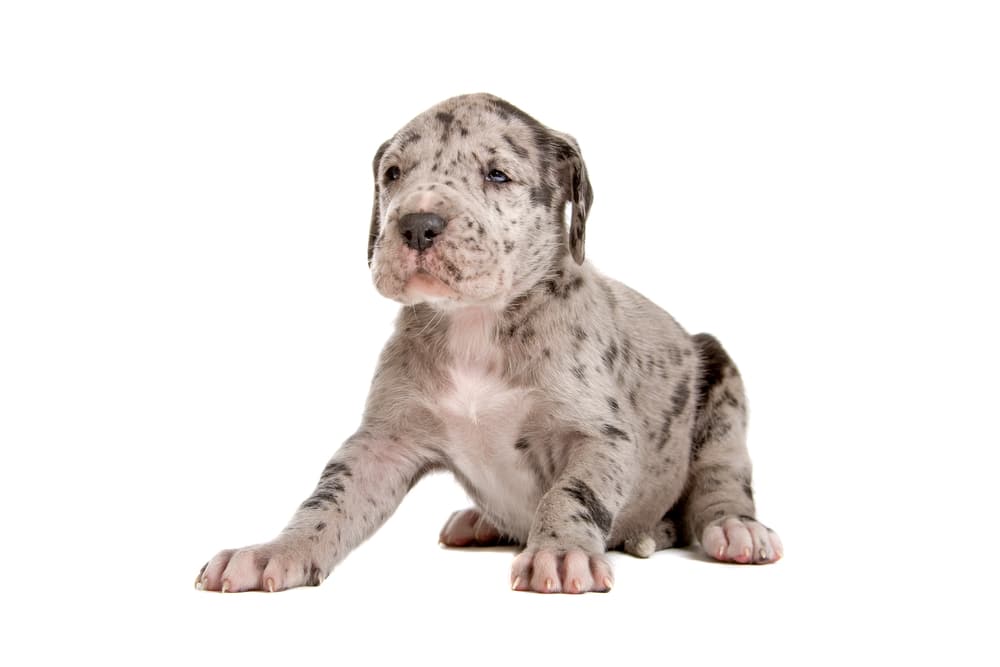
Patterns and Markings
According to AKC, a desirable Merle Great Dane should have the following patterns and markings:
May be Solid Merle (white on chest and toes is permissible) or Merle with a Mantle Pattern (solid merle blanket extending over the body; merle skull with a white muzzle; white blaze is optional; whole or partial white neck; a white chest; white on whole or part of the forelegs and hind legs; white tipped merle tail. A small white break in the blanket is acceptable. (Black pigment may be seen on the skin in white areas.)
Furthermore, a white Great Dane with patches of Merle is not considered as a Merle Great Dane. This is not an official color and is considered a mismark called Merlequin.
Breeding
Merle Great Danes are produced and born in many Harlequin litters. And breeding two Merle Great Dane is considered unethical according to GDCA standards. This is because breeding two Merles together produces a litter of double Merle puppies which are either blind, deaf or both.
Show Quality vs Pet Great Danes
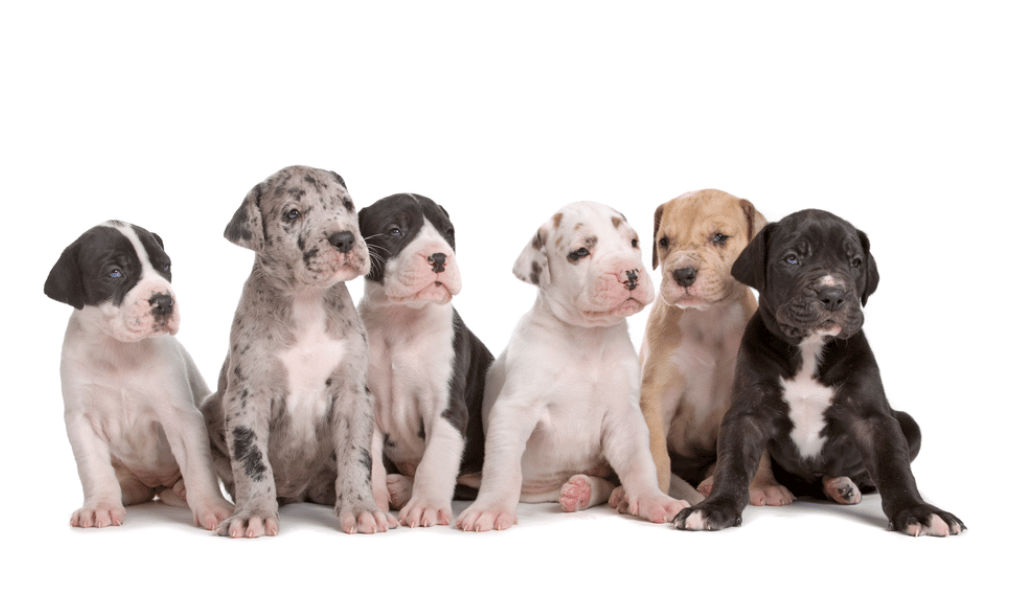
Commonly, Great Danes that follow the AKC and GDCA’s coat color and markings standards are sold as Show Quality Great Danes. They hold an edge over other Great Dane colors because they are the most popular, they are able to compete in dog shows and are an indication of how prone a Great Dane is to health problems.
While, “mismarked” Great Danes are sold as Pet Quality Great Danes. Mismarks are called as such because their coat colors and patterns do not conform to the breed standards. Mismarked Great Danes can have too much of a color, not enough of a color and/or have a color that isn’t according to the breed’s standard. For example, a Fawn Harlequin mismark or Fawnequin has golden yellow splotches across its body instead of black.
While not unusual, mismarks do not fit the breed standards, they cannot be part of dog show competitions and will be more predisposed to birth defects.
With a plethora of Great Dane colors, choosing a coat color is entirely up to you. But based on experience and suggestions from experts, it is better to select a Great Dane puppy having a coat color recognized by the AKC and GDCA. Or a coat color that is as close as possible to the breed standard.
Unofficial Great Dane colors
Aside from the seven official Great Dane colors, there are also occurrence of many other coat colors and patterns in Great Danes which are not recognized by the AKC and GDCA and are referred to as mismarks. And some of the most common colors are:
1. Fawnequin Great Danes
A Fanw Harlequin or Fawnequin Great Dane is a Harlequin mismark. The base coat color is white and has golden yellow-colored splotches. The patterns and colors could also vary, including Brindle and Merle.
If you are looking for a show dog, a Fawnequin is not something you’d like. But if you’re looking for a pet Dane, then a Fawnequin can be a good choice.
2. White Great Danes
Among all Great Dane colors, White Great Danes are the rarest. They are referred to as “Double Merles” because they hold two Merle genes. Dog shows and the AKC do not favor these Danes because they are prone to problems such as hearing and vision impairment. And breeding to produce White Great Danes is also considered unethical.
3. Black and White Great Danes
The Black and White Great Dane should not be confused with the Mantle. It is simply a Black Great Dane that has white markings on its body. As opposed to a Mantle who has predominantly white legs and a white chest that goes up to its body, the Black and White Dane’s markings are usually smaller and are found on the paws and chest.
4. Piebald Great Danes
Piebald Great Danes have a predominantly white coat colors and are sometimes confused with Harlequins and/or Mantles. Their difference with aforementioned Great Dane colors is that they only have one to three splotches across their bodies, a fully black head and a white muzzle.
Nevertheless, as long as you are fine with your Great Dane puppy breed’s lineage and health, you can pick any coat color that attracts you best.
Other Great Dane Colors
Many responsible breeders aim to improve a breed. If breeders truly follow moral breeding norms, the probability of having puppy of breed standard colors would be high. This cannot guarantee a 100% healthy Great Dane puppy, but it will ensure less Great Danes puppies being born with health problems.
Although, the variety in Great Dane colors is the result of conventional breeding, there are still some coat colors that are caused by accidental cross color breeding. These colors that are due to accidental or intentional cross color breeding are:
- Blue Brindle Great Dane
- Mantle Merle Great Dane
- Blue Fawn Great Dane
- Chocolate Brindle Great Dane
Conclusion
Regardless of their coat color, Great Danes are big, beautiful, loyal and social dogs.
However, you have to be cautious and understand that Great Dane colors are also an indication of their general well-being. A Great Dane color can give you an insight of the dog’s health and fitness. If you know and understand that other coat colors are more predisposed to health issues, then you will know how to care for your Great Dane properly.
But of course, If you want a show quality Great Dane, then the dog’s coat will most definitely matter. If what you’re looking for is a family companion, then its color might not be your biggest deal breaker. And you may want to buy or adopt a Great Dane that matches your temperament.
Whatever purpose you have in buying or adopting a Great Dane, you have to do your research and make sure that you are making an informed decision.
My great dane has fawn as her base coat. Her toes and chest are white and her face is grey with black spots. What is she considered color wise. I don’t know if she is brindle, dirty brindle, or fawnequin. Can you help.
Thank you,
Sincerely
Natalie Bellovich
So true about the white Dane. Sad, but true. My neighbor adopted (Or rescued) a white pup.
This dog, in all her magnificent glory, was indeed born deaf and almost blind.
She has had one eye removed altogether and is critically near-sighted in her one remaining eye. She is stone deaf. But what a sweetheart!
Mei-Li is truly a gentle giant and such a pleasure to share company with.
(LOL she has a “big sister” who is a 12 year old miniature Doberman. Quite the two extremes).
Regards
Jean
Hello. I have a newly acquired rescued Dane which is more of a lilac color. She is beautiful and is a companion dog. Can you tell me more about this color and what problems if any I may encounter?
Thank you.